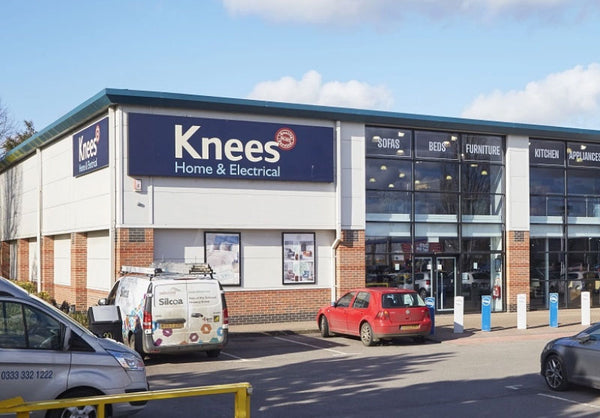Our guide to buying the best condenser tumble dryer
Choose your new condenser tumble dryer with ease with this buyers guide
Condenser tumble dryers offer a combination of the benefits of the other major dryer types. Here at Knees Home & Electrical, we stock a wide range from leading manufacturers. They can be placed almost anywhere because they don’t need a hose connection and this flexibility is one of their attractions. Bear in mind that even with a large condenser tumble dryer, it may be necessary to empty the water reservoir after each drying cycle, while a small condenser tumble dryer will almost invariably require emptying every time.
You can pay anything from £200 to £3,800 for a condenser tumble dryer, which reflects the variety of features available. In general, the price will be an indicator of quality but isn’t an absolute measure of the best condenser tumble dryer on the market.
Summary
- Understanding the different types of tumble dryers
- Key things to think about when choosing your next condenser tumble dryer
- Best condenser tumble dryer features to look out for
- Shop for the best condenser tumble dryer at Knees Home & Electrical
Understanding the different types of tumble dryers
There are three main types of tumble dryer, each of which meets different priorities. Vented tumble dryers remove moisture using a hose, either fitted to a wall vent or simply passed through a window. They work extremely well in these conditions and are generally the cheapest option to buy. Heat pump dryers are highly energy-efficient because they recycle hot air as part of the drying process but they can be slow.
Condenser dryers, as we have seen above, are a good compromise. They offer faster drying times than heat pump models, without the need for an external vent.
Key things to think about when choosing your next condenser tumble dryer
Firstly decide how you will fit the dryer into your kitchen or utility room. Fully integrated models are less common. Several well-known brands including Bosch and Hoover do manufacture them but demand is low. Semi-integrated machines are even rarer, fitted behind a door but with the control panel on permanent show. Free-standing dryers are the most common which may be partly because they are easier to use if access is unimpeded by built-in units.
Drum Size
A small condenser tumble dryer will have a drum size of about five to six kg, capable of handling a fairly small load of about five pairs of trousers and a couple of t-shirts or a single duvet. A medium model will take about seven to nine kg or a double duvet, while a large condenser tumble dryer of between 10 and 13kg can manage a full wash equivalent to 15-20 towels or a king-size duvet. Your choice will depend on how often you run a wash cycle and how much it contains. You may wish to match your dryer capacity with that of your washing machine.
Running Costs
Condensers are slightly more expensive to run than vented dryers. The Energy Saving Trust has calculated that the average cycle uses 4.5kWh and the Department for Business, Energy & Industrial Strategy measures the current average cost of electricity at 18.9 pence per kWh. Roughly speaking that’s 85p for an hour’s drying. You can use the sum of kWh times price as a basis to compare the performance of different models. Always check the energy rating before you buy.
Purchase Price
As we’ve mentioned, the price range is enormous. The more you can spend, the more likely you are to get the best condenser tumble dryer in terms of features. The good news is that for just a few hundred pounds, you can buy a reliable appliance that does a very good job without all the whistles and bells of the most expensive models.
Best condenser tumble dryer features to look out for
Technological advances have enabled manufacturers to incorporate remarkable new functionality into their condenser dryers. Actions that previously had to be carried out manually are now built into the cycle.
Sensor Drying
This eliminates the need for you to guess how wet your laundry is and estimate the drying setting that is most appropriate. Load the washing into the machine and its sensors will determine how wet the items are and therefore select the correct setting.
Anti-Crease
Many condenser dryers can remove wrinkles and tangles in clothes as they dry and even deodorise them. They may use a steam cycle or simply a period of intermittent tumbling in unheated air at the end of the drying process. This is an excellent time-saving function that minimises the need to iron clothes – most of them can be worn straight from the dryer. Reverse action performs a similar job, tumbling clothes in both directions, reducing both drying time and creases.
Fast Dry
Sometimes you need clean clothes in a hurry, such as sports kit or work clothes. You might have used a fast wash cycle but you still need to dry them. A short, sharp, fast-dry tumble cycle is the answer. It may not be a necessity but it is a very handy feature to have.
Door Size
This might not immediately come to mind as something to consider but when you need to dry large loads or outsize individual items such as duvets or sleeping bags, it can be really inconvenient to have to cram them through a small opening.
Easy Access Lint Filter
Filters are usually located in the door frame but some are easier to get at than others so you should look for one that is easy to open, empty and reinstall.
Filter Full Indicator
This feature can save you the trouble of dealing with the lint filter before it is necessary. Lint build-up is not consistent so rather than opening up the filter to check, a simple control panel indicator will tell you when it needs to be done.
Reservoir Location
Similarly, because it is necessary after each drying cycle to empty out the water that has collected, it’s important to choose a machine that makes this as easy as possible. A reservoir tucked away in an inaccessible corner is less than ideal. Ease of access is essential.
Intelligent Cleaning System
Some manufacturers, including Bosch and Miele, use automatic cleaning technology to remove fluff, lint and any other debris. This means an end to the chore of emptying the door filter every time you use the machine. That may not seem like a major job, but it’s one more time – and labour-saving – feature to consider.
Timers
Many of us transfer items to be tumbled to the dryer as soon as the wash cycle concludes. However, there can be a number of reasons to delay drying until a more convenient time. Examples include a dryer located in a kitchen diner where noise may be an issue or an energy tariff that offers off-peak rates. The option to set a timer means you can forget about it and let the dryer remember for you.
Smart Pairing
Artificial Intelligence is capable of extraordinary things and smart pairing between a washer and a dryer is a capability that allows the two appliances to communicate independently of the user. Once the wash is done, the washing machine can tell the condenser dryer everything it needs to know about the load it is about to receive and the dryer can automatically select the most suitable drying cycle. Perhaps not a priority for everyone, but a technological marvel nonetheless.
Shop for the best condenser tumble dryer at Knees Home & Electrical
As you see, there are many things to explore when trying to choose the best condenser dryer. It is worth deciding which features you find essential and then seeing how many of the optional ones you can add within your budget. If you require any additional information or advice in selecting a tumble dryer, our friendly team at Knees will be very happy to help. Please don’t hesitate to contact us. You’ll be sure to find the best condenser tumble dryer with us here at Knees!
FAQ’s
Where can I put a condenser tumble dryer?
You can place a condenser tumble dryer anywhere in the home as they simply plugin and they’re ready to go. They collect water from your laundry in a container which is inside the machine. The dryer will then let you know when the container is full and it’s then really easy to remove and empty it.
What is a condenser tumble dryer?
A condenser tumble dryer collects moisture from your wet clothes in a container, sometimes referred to as a reservoir, this is located within the dryer itself. The tank collects the water and then when it is full all you have to do is empty it. Most modern models will tell you when the tank is full.



